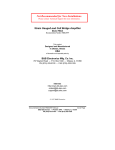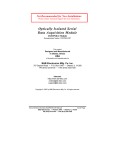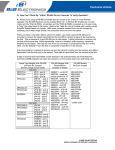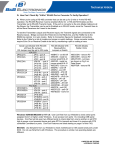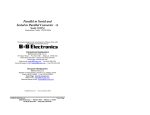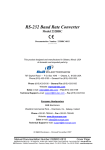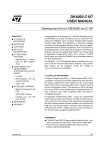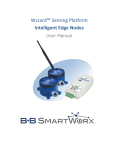Download B&B Electronics TCDA Specifications
Transcript
Not Recommended for New Installations. Please contact Technical Support for more information. K-type Thermocouple Amplifier Model TCDA Documentation Number TCDA0997 This product Designed and Manufactured In Ottawa, Illinois USA of domestic and imported parts by B&B Electronics Mfg. Co. Inc. 707 Dayton Road -- P.O. Box 1040 -- Ottawa, IL 61350 PH (815) 433-5100 -- FAX (815) 433-5100 Internet: http://www.bb-elec.com [email protected] [email protected] Copyright © 1997 by B&B Electronics Mfg. Co. All rights reserved. Documentation Number TCDA0997 Manual Cover Page B&B Electronics -- PO Box 1040 -- Ottawa, IL 61350 PH (815) 433-5100 -- FAX (815) 433-5104 TABLE OF CONTENTS CHAPTER 1: INTRODUCTION ..................................................................... 1 FEATURES ......................................................................................................... 1 PACKING LIST ................................................................................................... 1 SOFTWARE ........................................................................................................ 2 SPECIFICATIONS ................................................................................................ 2 CHAPTER 2: THERMOCOUPLE OVERVIEW........................................... 3 CHAPTER 3: CONNECTIONS ....................................................................... 5 OVERVIEW ........................................................................................................ 5 THERMOCOUPLE CONNECTIONS........................................................................ 5 POWER SUPPLY CONNECTIONS ......................................................................... 5 OUTPUT CONNECTIONS ..................................................................................... 5 CHAPTER 4: CALIBRATION ........................................................................ 7 OVERVIEW ........................................................................................................ 7 CALIBRATION PROCEDURE FOR STANDARD TCDA MODULES .......................... 7 CALIBRATION PROCEDURE FOR MODIFIED TCDA MODULES ........................... 8 CHAPTER 5: VOLTAGE-TO-TEMPERATURE........................................ 11 CHAPTER 6: SOFTWARE ............................................................................ 13 INSTALLATION ................................................................................................ 13 APPENDIX A: TCDA CIRCUIT SCHEMATIC ......................................... 15 TCDA BOARD LAYOUT .................................................................................. 16 Documentation Number TCDA0997 Manual Table of Contents B&B Electronics -- PO Box 1040 -- Ottawa, IL 61350 PH (815) 433-5100 -- FAX (815) 433-5104 i Chapter 1: Introduction Features The TCDA is a thermocouple amplifier that can be used with B&B Electronics’ Data Acquisition modules to measure temperature using a PC. The two channels of the TCDA support K-type thermocouples. The amplifier has an output range of 0VDC to +5VDC. The standard TCDA can measure temperatures between -50°C and 200°C. The module can be modified at the factory so that a different temperature range can be measured. Packing List Examine the shipping carton and contents for physical damage. If there is any damage, contact B&B Electronics immediately. The following items should be in the shipping carton: 1. The TCDA module. 2. This instruction module 3. 3.5” disk If any of these items are missing, contact B&B Electronics. Figure 1.1: TCDA module Documentation Number TCDA0997 Manual B&B Electronics -- PO Box 1040 -- Ottawa, IL 61350 PH (815) 433-5100 -- FAX (815) 433-5104 1 Software Software used with B&B Electronics’ SDAXX, SPDA and ADIO12 modules to control the TCDA module is included with the TCDA. This software is very similar to the software included with the SDAXX, SPDA and ADIO12 module but with some minor modifications. To install the software in your PC: 1. Place the disk in drive A. 2. Type A: and press the <ENTER> key. 3. Type INSTALL and press the <ENTER> key. 4. Follow the instructions given by the program. Specifications Size: 4.8” x 2.2” x 0.9” Channels: 2 Resolution: 20mV/°C Input Voltage Offset: 150µV Input Voltage Offset Drift: 1.5µV/°C o Temperature Measurement Range: -50 C to 200°C 0 TCDA Operating Temperature: 0 C to 70°C Maximum Temperature Error: +/- 3°C Power Requirements: 12 to 16VDC @ 10mA Output Voltage Range: 0 to 5VDC The TCDA module will operate in an environment between 0°C and 70°C but can measure temperatures between -50°C and 200°C. 2 Documentation Number TCDA0997 Manual B&B Electronics -- PO Box 1040 -- Ottawa, IL 61350 PH (815) 433-5100 -- FAX (815) 433-5104 Chapter 2: Thermocouple Overview To understand the operation of the TCDA it is necessary to understand the basic construction of the thermocouple. A thermocouple consists of two solid wires, composed of dissimilar metals, joined at one end. The joining of dissimilar metals generates a small DC voltage based on the temperature of this junction. The TCDA amplifies this small voltage to a usable level for A/D converters. The output of a thermocouple does not have a linear relationship with temperature. A close approximation for a K-type thermocouple is 40.6µV/°C. This approximation is used with the TCDA. Figure 2.1 contains a plot of thermocouple output voltage over a temperature range. Figure 2.1: Thermocouple Non-linearity 0.0406 Output Voltage ( V) Note: This plot is not to scale, and the nonlinearity has been exagerated. Ideal line (40.6uV/C) Actual thermocouple output 0 0 Temperature O ( C) Documentation Number TCDA0997 Manual B&B Electronics -- PO Box 1040 -- Ottawa, IL 61350 PH (815) 433-5100 -- FAX (815) 433-5104 1000 3 The error caused by the thermocouple non-linearity over the -50°C to 200°C range is relatively small, so it is ignored in the factory calibration of the TCDA. If more accurate readings must be taken, the following techniques can be used: 1. If all temperatures are taken near a certain temperature, calibrate the TCDA at that particular temperature. 2. Implement a look-up table in your software program to correct for error. 3. Use a piece-wise linear model for your thermocouple output to correct for error. The terminal blocks on the TCDA and the leads of the thermocouple bead are made from dissimilar metals. This creates a second, unwanted thermocouple at the terminal blocks. This unwanted thermocouple is called the cold junction. The temperature of this cold junction will affect the results of the actual thermocouple. The TCDA has cold junction compensation that automatically corrects for small changes in the cold junction temperature. It is important that nothing comes in contact with the terminal blocks or the two external diodes near the terminal blocks as this may cause large, rapid changes in the cold junction. The cold junction should be kept at a constant temperature, if possible. Different types of thermocouples are made by joining a wide variety of metals. The TCDA is designed to amplify K-type thermocouple only. Thermocouples have a positive(+) and a negative(-) lead. These two leads must be connected to the correct terminals on the TCDA module. Connections will be covered in the next chapter. 4 Documentation Number TCDA0997 Manual B&B Electronics -- PO Box 1040 -- Ottawa, IL 61350 PH (815) 433-5100 -- FAX (815) 433-5104 Chapter 3: Connections Overview This chapter will discuss the connections required to operate the TCDA thermocouple amplifier. Connections between the A/D converter and the TCDA should be kept as short as possible. Thermocouple Connections The TCDA can amplify voltage from a K-type thermocouple. Only one thermocouple can be connected to each channel. The thermocouple connections are made using terminal blocks. The positive (+) lead of the thermocouple must be connected to T1+ and the negative (-) lead to T1- (T2+ and T2- for channel 2). Make sure that both leads of the thermocouple are connected to the same channel. Color coding is used to designate the thermocouple’s polarity. A K-type thermocouple’s negative lead is red, and the positive lead is yellow. Figure 3.1 shows the thermocouple connections. Power Supply Connections A 2.5mm power jack is provided on the side of the TCDA hood. A 12VDC power supply must be connected to the 2.5mm power jack. The 232PS is recommended (not included). Output Connections The amplified voltage of the thermocouple is available through a male DB-25P connector. This connector is pin compatible with B&B Electronics’ ADIO12 and SDAXX line of data acquisition modules. The FBDA can also be used with the SPDA data acquisition modules. The pinout of the TCDA is shown if Table 3.1. Figure 3.1 shows the connections required for the TCDA module. Documentation Number TCDA0997 Manual B&B Electronics -- PO Box 1040 -- Ottawa, IL 61350 PH (815) 433-5100 -- FAX (815) 433-5104 5 Thermocouples red yellow red yellow channel 1 channel 2 Pin 17 and 18 are internally connected in the TCDA to provide +5V to REF+ in the XXXSDAXX and XXXSPDA modules (AGND to AGND in the ADIO12 module). GND GND TC #0 TC #1 GND 1 1 7 7 8 8 9 9 17 17 18 18 19 19 A/D Module TCDA Module 2.5mm Power Jack Power Supply T1+ T1- T2+ T2GND GND A/D ch. A/D ch. +5VDC REF+ REF- RS-232 or RS-485 Port Figure 3.1: TCDA Connections NOTE: A 12VDC power supply must be connected to the TCDA’s 2.5mm power jack. Table 3.1: Pinout of TCDA Module Pin # 1 2 3 4 5 6 7 8 9 10 11 12 13 Function GND ------------------------------GND TC # 0 TC # 1 ------------------------- Pin # 14 15 16 17 18 19 20 21 22 23 24 25 Function ------------------looped to pin 18 looped to pin 17 GND ------------------------------------- 1. ------- denotes that pin is not used. 2. Pin 17 and 18 are internally connected to each other to provide 5VDC to REF+ for the SDAXX modules. 3. Pin 19 is internally connected to GND to provide 0VDC to REFfor the SDAXX and SPDA modules. 6 Documentation Number TCDA0997 Manual B&B Electronics -- PO Box 1040 -- Ottawa, IL 61350 PH (815) 433-5100 -- FAX (815) 433-5104 Chapter 4: Calibration Overview The standard TCDA module is calibrated at the factory for a temperature range of -50°C to 200°C. With a resolution of 20mV/°C and an offset voltage of -1.0VDC. The offset voltage shifts the negative voltages produced at temperatures below 0°C to voltage greater than 0VDC. The TCDA modules that have modified temperature ranges are not calibrated at the factory. The user must calibrate these modules. The calibration process described below is the process used at the factory. The calibration process for a different temperature range is similar, but the values will differ. The non-linearity of the thermocouple over the -50°C to 200°C range is relatively small, so it is ignored in the factory calibration process. If you require more accurate readings, you may want to consider using one of the techniques mentioned in Chapter 2. Calibration Procedure for Standard TCDA Modules During the calibration process and while measurements are being taken, do not touch the terminal blocks or external diodes near the terminal blocks! Items required: 1. Small slotted screwdriver. 2. DC voltmeter with 10mV readability (0.01V). 3. Ice slurry - container (cup, glass, etc.) filled with ice and then add water to cover ice, container of boiling water (be careful!), or substance of known temperature that can be used to calibrate the TCDA. The following steps are used to calibrate channel 1 of the TCDA module. The TCDA can operate in a temperature between 0°C and 70°C. It is a good idea to calibrate the TCDA at the same ambient temperature that the module will be taking measurements in. Information in parenthesis ( ) is used for channel 2 calibration. Documentation Number TCDA0997 Manual B&B Electronics -- PO Box 1040 -- Ottawa, IL 61350 PH (815) 433-5100 -- FAX (815) 433-5104 7 1. Remove the cover from the TCDA module. 2. Connect thermocouple to terminal blocks T1+ and T1- as described in Chapter 3 (T2+ and T2- for channel 2). 3. Plug power supply in 2.5mm power jack and plug supply into wall outlet. 4. Adjust P2 so that there is -1.0VDC on pin 6 or 7 of U1 (adjust P3 so that there is -1.0VDC on pin 6 or 7 of U3 for channel 2). See Appendix A for board layout schematic. 5a. If you are using an ice slurry, place the thermocouple in the center on the ice slurry. Wait several minutes for the ice slurry to stabilize at 0°C. Adjust P1 so that the voltage on DB-25 pin 8 is 1.00VDC (adjust P4 so that the voltage on DB-25 pin 9 is 1.00VDC for channel 2). 5b. If you are using a container of boiling water, place the thermocouple in the water as it begins to boil. Adjust P1 so that the voltage on DB-25 pin 8 is 3.00VDC (adjust P4 so that the voltage on DB-25 pin 9 is 3.00VDC for channel 2). 5c. If you are using some other substance with a known temperature, place the thermocouple in the substance. Adjust P1 so that the voltage on DB-25 pin 8 is equal to the calculated value of Vout for the temperature of the substance (adjust P4 so that the voltage on DB-25 pin 9 is the calculated value for Vout for temperature of the substance). Calibration Procedure for Modified TCDA Modules The following is for modified temperature ranges only. If you have a standard TCDA module, you can skip this section. The procedure for calibration modified temperature ranges is similar to the process discussed above. The modified temperature range, values for Voff and resolution, and the modified Voltage-toTemperature Conversion Equation are included with modified TCDA modules. Vout is the voltage on DB-25 pin 8 (DB-25 pin 9 for channel 2) that represents temperature. 8 Documentation Number TCDA0997 Manual B&B Electronics -- PO Box 1040 -- Ottawa, IL 61350 PH (815) 433-5100 -- FAX (815) 433-5104 1. Remove the cover from TCDA module. 2. Connect thermocouple to terminal blocks T1+ and T1- as described in chapter 3 (T2+ and T2- for channel 2). 3. 4. Plug power supply in 2.5mm power jack and plug supply into wall outlet. 5. Adjust P2 so that there is Voff on pin 6 or 7 of U1 (adjust P3 so there is Voff on pin 6 or 7 of U3 for channel 2). 6. Place the thermocouple in a substance with a known temperature. Adjust P1 so that the voltage on DB-25 pin 8 is equal to the calculated Vout (adjust P4 so that the voltage on DB-25 pin 9 is equal to the calculated Vout for channel 2). Documentation Number TCDA0997 Manual B&B Electronics -- PO Box 1040 -- Ottawa, IL 61350 PH (815) 433-5100 -- FAX (815) 433-5104 9 Chapter 5: Voltage-to-Temperature In standard TCDA modules the low temperature is -50°C and the high temperature is 200°C. These temperatures correspond to an output voltage between 0 and 5VDC. The Voltage-to-Temperature Conversion Equation for standard TCDA modules is shown below. Voltage-to-Temperature Conversion Equation Temperature° C = Vout + Voff resolution NOTE: Do not use this equation if you have a modified TCDA module. The following values are used for standard TCDA modules: -50°C < Temperature < 200°C 0VDC < Vout < 5VDC Vout is measured on DB-25 pin 8 ( pin 9 for channel 2) resolution = 20mV/°C = 0.02V/°C Voff = -1.0VDC TCDA modules with modified temperature measurement ranges will be supplied with temperature range, values for Voff, and resolution, and a modified Voltage-to-Temperature Conversion Equation. The Fahrenheit-to-Centigrade and Conversion Equations are shown below. Centigrade-to-Fahrenheit C-to-F and F-to-C Conversion Equations C= 5 × ( F − 32) 9 F= 9 × C + 32 5 Documentation Number TCDA0997 Manual B&B Electronics -- PO Box 1040 -- Ottawa, IL 61350 PH (815) 433-5100 -- FAX (815) 433-5104 11 Chapter 6: Software Included with the TCDA module is a diskette with software examples written in Borland C++, Borland Pascal and Microsoft® QuickBASIC v4.5. These DOS-based example program show how to access the TCDA module connected to the following modules: • • • • • • • • • 232SDA10 232SDA12 232SPDA 232SPDACL 485SDA10 485SDA12 485SPDA 485SPDACL ADIO12 Installation To install the example files on your hard drive: • • • • Place the disk in drive A. Type A: and press the <ENTER> key. Type INSTALL and press the <ENTER> key. Follow the instructions given by the program. After the software installation is complete, the file, FILES.LST, contains a list of installed files with a brief description of each. The file, HISTORY.LST, contains a description of each revision to the software files. The file, READ.ME, contains corrections and additions to the printed documentation. The file, MAKEIT.BAT, in the subdirectory for each module is an example of how to compile and link the example program in each language. This file may need to be modified to use the path to your compiler. Documentation Number TCDA0997 Manual B&B Electronics -- PO Box 1040 -- Ottawa, IL 61350 PH (815) 433-5100 -- FAX (815) 433-5104 13













